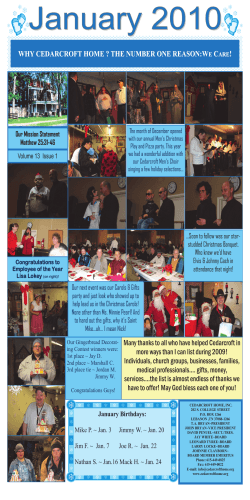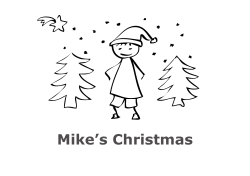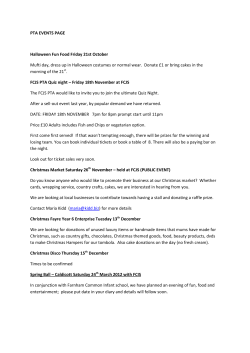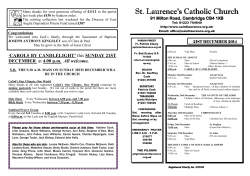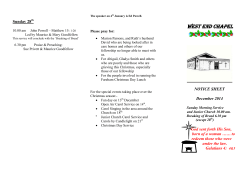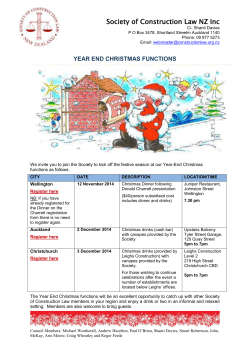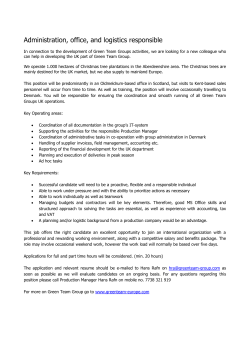
CONCEPT NOTES
Pasig Catholic College Grade School Department S.Y. 2014 – 2015 MUSIC 6 Fourth Quarter CONCEPT NOTES CAROL Learning Objectives: To understand what a carol is To learn a short history of the carol To know the difference between a Christmas carol and a song Christmas Reference : http://en.wikipedia.org/wiki/Christmas_carol http://en.wikipedia.org/wiki/Carol_%28music%29 http://en.wikipedia.org/wiki/Christmas_music Concept Notes : • • • Christmas music comprises a variety of genres of music normally performed or heard around the Christmas season. A carol is, in modern parlance, a festive song, generally religious but not necessarily connected with church worship, and often with a dance-like or popular character. Songs which are traditional, even some without a specific religious context, are often called Christmas carols. Each of these has a rich history, some dating back many centuries. HISTORY • Music was an early feature of the Christmas season and its celebrations. The earliest chants, litanies, and hymns were Latin works intended for use during the church liturgy, rather than popular songs. The 13th century saw the rise of the carol written in the vernacular, under the influence of Francis of Assisi. • In the Middle Ages, the English combined circle dances with singing and called them carols. Later, the word carol came to mean a song in which a religious topic is treated in a style that is familiar or festive. From Italy, it passed to France and Germany, and later to England. Christmas carols in English first appear in a 1426 work of John Audelay, a Shropshire priest and poet. • During the Commonwealth of England, the government under Cromwell prohibited the singing of Christmas carols, considering it as pagan and sinful like other customs associated with popular Catholic Christianity. The Westminster Assembly of Divines established Sunday as the only holy day in the calendar in 1644 and so legally abolished Christmas. Prepared by: Mr. Norberto Edades • May 1660 Charles II restored the Stuarts to the throne, England once again practiced the public singing of Christmas carols. • The tradition of singing Christmas carols in return for alms or charity began in England in the 17th century after the Restoration. Town musicians or 'waits' were licensed to collect money in the streets in the weeks preceding Christmas, the custom spreading up to the present day. Also from the 17th century, there was the English custom, predominantly involving women, of taking a wassail bowl to their neighbors to solicit gifts, accompanied by carols. Christmas carols in our predominantly Catholic country exhibit the influence of indigenous, Hispanic, and American musical traditions, reflecting the country's complex history. Carollers (Tagalog: Namamaskô) begin wassailing in November, with mostly children and young adults participating in the custom. • PHRASE Learning Objectives: Distinguish the phrases of the song Locate the beginning and ending of phrases Reference : RADIANCE, pp. 51 – 58 by Codog, Lagarto, Lodronio, Sinugbuhan Concept Notes : v In music, a line of the song that expresses a complete idea/thought is called a musical phrase. And because of this, it can be compared to a sentence in language. v Typically a musical phrase consists of three-or four-bar units which is complete in itself. v The length of a musical phrase varies. Some phrases are short; some are long. v The letters of the alphabet (i.e., A, B, C, D, etc.) can be used to name the phrases of a song v A long curved line ( ) is a symbol for a phrase. v Every song has a beginning and ending phrase. v The beginning phrase is found on the first staff of the music piece. It gives the idea of what the song is all about. v On the other hand, most ending phrase is found on the last staff of the music piece, but sometimes it is found at the middle. The sign Fine indicates the end of a song. Prepared by: Mr. Norberto Edades VOICE CLASSIFICATION Learning Objectives : Know the different voice types Distinguish the different voice types from one another Determine one’s voice type Find out the use of voice classification Concept Notes: v Knowing our singing voice well leads to efficient vocal training v A VOICE TYPE is a particular kind of human singing voice perceived as having certain identifying qualities or characteristics. v VOICE CLASSIFICATION is the process by which human voices are evaluated and are thereby designated into voice types. These qualities include but are not limited to: 1. Vocal range 4. Vocal timbre 2. Vocal weight 5. Vocal transition points such as breaks and 3. Vocal tessitura lifts within the voice. v Voice classification is a tool for singers, composers, venues, and listeners to categorize vocal properties, and to associate possible roles with potential voices. v These are the different voice types: A. FEMALE > SOPRANO - the highest female voice - includes such singers as : Rosa Ponselle, Maria Callas, Beverly Sills > MEZZO SOPRANO - the middle-range voice type for females - lies between the soprano voice and alto voice, overlapping both of them. > ALTO - the lowest female voice B. MALE > TENOR - the highest male voice - famous tenors include : Enrico Caruso, Mario Lanza, Luciano Pavarotti > BARITONE - the most common type of male voice - the vocal range of the baritone lies between the bass and tenor ranges, overlapping both of them > BASS - the lowest male voice C. CHILDREN > TREBLE Prepared by: Mr. Norberto Edades - the term treble can refer to either a young female or young male singer with an unchanged voice - the vocal range and timbre of children's voices does not have the variety that adults' voices have. - both boys and girls prior to puberty have an equivalent vocal range and timbre. The reason for this is that both groups have a similar laryngeal size and height and a similar vocal cord structure. With the onset of puberty, both men and women's voices alter as the vocal ligaments become more defined and the laryngeal cartilages harden RONDALLA INSTRUMENTS Learning Objectives: identify visually and aurally the instruments used in rondalla Distinguish the sounds of the different rondalla instruments Show appreciation for the instrumental music of the rondalla Develop admiration and enjoyment in listening to Filipino folk music Reference : RADIANCE, pp. by Codog, Lagarto, Lodronio, Sinugbuhan http://en.wikipedia.org/wiki/Rondalla http://en.wikipedia.org/wiki/Bandurria http://en.wikipedia.org/wiki/La%C3%BAd http://en.wikipedia.org/wiki/Octavina Concept Notes : • RONDALLA INSTRUMENTS are all stringed instruments. They are played with a plectrum or a pick Rondalla provides music for the Philippine folk dances. It is very famous and common in community celebrations like fiestas, weddings and other social and civic events. • It originated in Medieval Spain, especially in Catalunya, Aragon, Murcia, and Valencia. The word rondalla is from the Spanish ronda, meaning "serenade." • Rondalla instruments have fourteen (14) strings except for the guitar and the double bass. • The instruments of the rondalla are: • Ø BANDURRIA - the bandurria usually carries the main melody; but also sometimes play the counter melody. - the strings of the bandurria are distributed as follows - starting with the lowest string: 3, 3, 3, 2, 2, 1. Ø LAUD Prepared by: Mr. Norberto Edades - the laud (Spanish 'lute’) plays the lower notes in accompaniments and contrapuntal lines. - it is shaped like a bandurria but bigger and has a longer neck. - it is tuned exactly as the bandurria except that it is one octave lower. Ø OCTAVINA - the octavina plays the tenor part or the counter melody of the composition. - it is like a guitar with a shorter neck. - it is tuned like the laud Ø GUITAR - the guitar used in rondalla is no different from the usual one - has six (6) strings - it plays the harmony part; sounded by both plucking or strumming Ø DOUBLE BASS - the double bass is the largest instrument in the rondalla family - it gives the solidness in rhythm. - the double bass used in rondalla is also no different from the double bass used in other instrumental ensembles – has four (4) bass strings • TUNING OF THE RONDALLA INSTRUMENTS: INSTRUMENTS 1ST STRING 2ND STRING 3RD STRING 4TH STRING 5TH STRING 6TH STRING Bandurria Laud Octavina Guitar Double Bass G5 (3) G4 (3) G4 (3) E4 G3 D5 (3) D4 (3) D4 (3) B3 D3 A4 (3) A3 (3) A3 (3) G3 A2 E4 (2) E3 (2) E3 (2) D3 E2 B3 (2) B2 (2) B2 (2) A2 - F#3 (1) F#2 (1) F#2 (1) E2 - RONDALLA INSTRUMENTS BANDURRIA LAUD OCTAVINA GUITAR DOUBLE BASS Prepared by: Mr. Norberto Edades
© Copyright 2025

